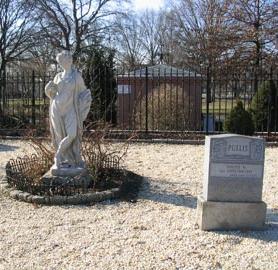This non-profit, publicly supported organization was founded on January 16, 1993 by Ed Shusterich, President and Juniper Park Warden, in his efforts to restore and maintain an historical landmark cemetery in Juniper Valley Park, Middle Village, Queens, Mr. Shusterich’s purpose is to further enhance and continue to maintain the quality of life and community spirit for civic betterment.
The once forgotten and decrepit site has been restored to a place of beauty. It has been transformed into a tranquil and peaceful garden, a fitting tribute to the memory of the Pullis pioneer family of Middle Village. It is a wonderfully scenic area in Middle Village and the Pullis landmark, in particular, is both an attractive landmark and an important element of Queens heritage.
The East lawn area of the park, east of 80th Street, was originally part of the Pullis farm. The burial ground located on Juniper Boulevard north and 81st Street once belonged to the Pullis family. This fenced area is the location of the remains of Thomas Pullis and two others.
As a result of the ban on burials in Manhattan in 1851, and the need for burial sites, homeowners began to bury their loved ones within their own lands. The earliest solution was to fence off a corner of the family farm and make it into a private burial ground. There were many such plots in Queens, but the breaking up of these farms into small parcels of land for residential purposes, and the coming of the grid system of streets in Queens, left the plots isolated and only a few private cemeteries remain today. The Pullis Cemetery is one of the few remaining Early American farm burial grounds in Middle Village, which was once known as Nassau Heights and later, Newtown.
Early development of Middle Village dates to the great influx of European immigrants in the 1840’s with the original settlers being mostly English and Dutch. They came with the primary purpose of establishing farms. Thomas Pullis, Sr. purchased a 32 acres farm in Middle Village in 1822 and the cemetery was created in 1846 with the burial of a child and is one of the few surviving farm burial grounds in New York City.
According to 1932 records, the Pullis family cemetery contained five or seven graves. Many of the headstones were missing or broken and the only fully identifiable name was that of Thomas Pullis, Sr. who died in 1854. The report notes that the site was “overgrown with weeds and marble tombstones have been torn out.” A 1932 survey found that there were originally three marble headstones: one for Thomas Pullis, Sr. (d. 1854), another bearing the letters “J.H.G.,” and one broken with only the letters “ETH N” remaining (d. 1846).
Pullis died in 1854 and his farm was bequeathed to his three sons, with the instructions that the cemetery was never to be sold. In his estate funds were provided to build a brick wall around the cemetery so that it would be protected.
In his will dated 5/8/1854, proved 7/19/1854 (Liber 6:311) (Thomas Pullis Sr., of Newtown) Sons: Thomas, Jr. (received northern part of farm) James H (received center part of farm) Washington (received southern part of farm)
Thomas Pullis, Sr. headstone inscriptions:
Thomas Pullis, Sr. Born: 1778
Died: 15 May 1854
Aged: 76 years, 5 months, 15 days
The above was then in the private cemetery on the Pullis farm in an area then called Nassau Heights, Queens County. (Alice H. Meigs, Editor, description of private and family cemeteries in the Borough of Queens, complied by the Topographical bureau, 1932.)
In addition to Juniper Valley Park, established in 1938, another portion of Pullis’ property was sold to the Parish of St. Margaret’s for the site of their church, built in 1860. The property purchased for the church was 300 feet on Pullis Avenue (now called 79th Place) and 150 feet on Juniper Swamp Road (now called Juniper Valley Road).
Middle Village received its name during the 1850’s as a result of its position – halfway from Williamsburgh to Jamaica on the Williamsburgh and Jamaica Turnpike Road, now Metropolitan Avenue. It became the farmers’ route to the Brooklyn ferry and also a stagecoach route. This territory was approximately halfway between Jamaica and the ferry landing, so it was named “Middle Village.” In those days, the boundaries of Middle Village began at the intersection of the Williamsburgh and Jamaica Turnpike Road and Fresh Pond Road and extended eastward to Woodhaven Avenue. Most occupants farmed the land and traveled over dirt roads.
Pullis and other local farmers brought their vegetables, fruit and other produce to market. Pullis traveled to the ferry landing at English Kills on Newtown Creek and then onto the ferry which took him to Catherine Market in Manhattan. On his way to Manhattan, Pullis, with others, would often stop at a roadside tavern for a bite to eat. This tavern was Niederstein’s Restaurant, which opened in 1845.
The Pullis landmark with all its improvements has made this the Central Park of Queens and is a beautiful passive expanse of greenery where people of all ages spend time together. The existing scope of work for the Juniper Park Renovation Project of the East lawn does address passive recreational facilities such as landmarks, landscaping, lighting, walkways and greenery.



